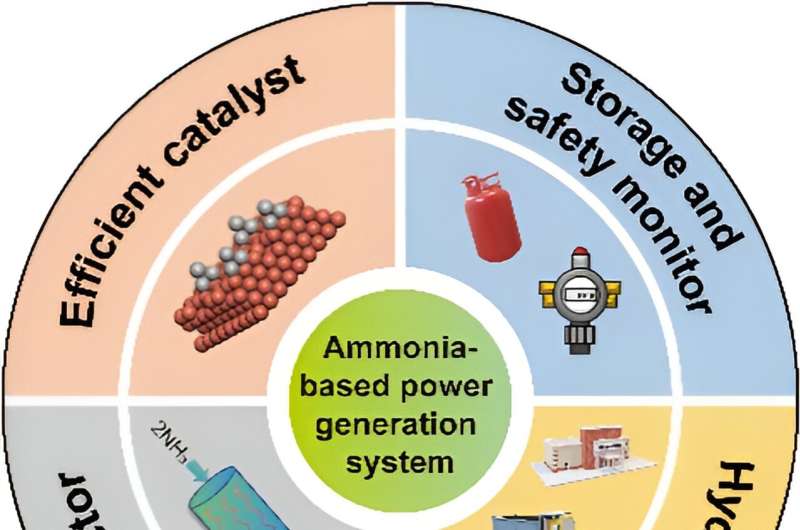This article has been reviewed according to Science X's editorial process and policies. Editors have highlighted the following attributes while ensuring the content's credibility:
fact-checked
proofread
Ammonia as a carbon-free hydrogen carrier for fuel cells: A perspective

Due to the environmental and energy problems caused by fossil fuels, the search for alternative clean and renewable energy solutions has never been more urgent. Among these, hydrogen (H2) is emerging as a leading contender in the energy sector for both stationary and mobile applications. However, the commercial utilization of hydrogen fuel cells is hindered by the challenges of handling and transporting hydrogen due to its low volumetric energy density.
Fortunately, ammonia (NH3) is emerging as a promising hydrogen carrier due to its high hydrogen content (17.6 wt%) and potential economic benefits for energy production. When used as a fuel, it produces only nitrogen and water as byproducts, making it a carbon-free alternative to traditional fossil fuels.
It can liquefy at a low pressure of 0.86 MPa at 25 ℃, providing a high volumetric energy density of 10.5 MJ L-1, which is twice that of compressed hydrogen at 70 MPa (5 MJ L-1). A team of scientists systematically discussed the potential of utilizing ammonia as a hydrogen carrier for on-site power generation via ammonia decomposition. Their work is published in Industrial Chemistry & Materials.
"There has been growing interest in the utilization of ammonia as an energy vector," said Zhonghua Xiang, a Professor at Beijing University of Chemical Technology.
"In this perspective, we addressed the chemical properties along with recent projects or worldwide chemical plants. Furthermore, we discussed the design strategies of catalysts and reactors, as well as their benefits and drawbacks. We hope this perspective could shed light on the potential of ammonia as a promising alternative to traditional hydrogen storage methods and highlights the challenges and opportunities that lie ahead in this exciting field of research."
As mentioned, storing renewable energy in the form of chemical fuels is deemed a pragmatic approach for both short- and long-term storage, especially in the transportation sector. In this regard, NH3 has been recommended as the more technically feasible option than CH3OH due to its advantageous chemical properties.
The gravimetric H2 content of NH3 is 40% higher than CH3OH, while maintaining a comparable volumetric energy density. Additionally, for carbon-based fuels, obtaining pure carbon dioxide streams from industrial emissions may not be a viable long-term solution, and the expense for directly capturing carbon dioxide from the air is high.
"One of the primary limitations of ammonia is its apparent toxicity, which is approximately three orders of magnitude greater than that of methanol or gasoline. To ensure safe use, recommended exposure limits for NH3 are set below 100 ppm," Xiang said.
"However, it is possible to monitor potential NH3 leaks and hazards in real-time using appropriate sensors. Furthermore, the human nose can detect ammonia at concentrations as low as 5 ppm in air, making it much more noticeable than odorless hydrogen. Therefore, it is practical to carry out appropriate hazard management to effectively mitigate the risk of ammonia exposure to both humans and the environment."
"The application of ammonia for power generation systems can be either stationary or portable, making it even more attractive," explained Dr. Lingling Zhai, a researcher in Xiang's group.
"In China, Jiang's team from Fuzhou University developed a demonstration project that utilizes ammonia for on-site hydrogen production at a hydrogen fueling station, aiming to create a zero-carbon-emission energy community. Currently, the American technology startup company, Amogy, is launching testing operations for a 200 kW tugboat for maritime applications in cooperation with the Sustainable Energy Catapult Center in Norway."
"International organizations such as the Ammonia Energy Association (AEA), the International Renewable Energy Agency (IRENA), and the Oxford Institute for Energy Studies (OIES) have also made significant efforts to promote the application of ammonia as a sustainable energy commodity," Zhai said.
To apply ammonia-based power generation systems, several aspects should be considered: 1. To avoid possible leakage of ammonia, the storage tank and all connected components should use anti-corrosion materials. 2. Low-temperature (< 450 ℃) ammonia decomposition catalysts, and reactors with high volumetric energy densities are highly required. 3. Relevant policies and regulations that incentivize the adoption of renewable energy sources can help accelerate the transition to a low-carbon economy.
"With the context of the above discussions, we expect an "ammonia to hydrogen" economy may ease the scalable use of green hydrogen in the foreseeable future," Xiang said.
More information: Lingling Zhai et al, Ammonia as a carbon-free hydrogen carrier for fuel cells: a perspective, Industrial Chemistry & Materials (2023). DOI: 10.1039/D3IM00036B


















